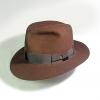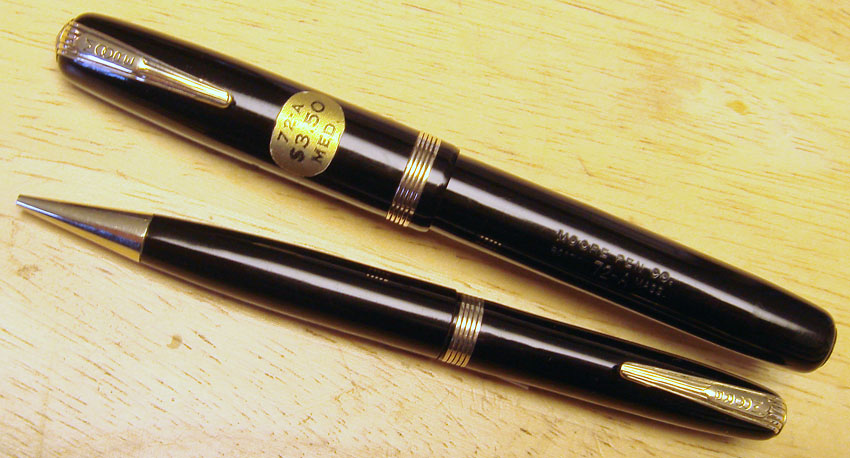I don't really understand the documents or the connection with the non-standard bands on Vacumatics (or the parallel-lines-banded Lustraloy "51" cap). Some questions:
- What does "DL" stand for (in e.g. "Brown Maxima DL Pen")?
- What indications are there that any of the items labeled as part of the credit jewelers line sport "stacked coin" or other non-standard cap bands?
- What is special about what seem to be Parker "51" pencils designated as associated with the credit jewelers line?
- Is it possible that the credit jewelers line is merely a subset of the full line, excluding the more-expensive items to minimize the jewelers' risk, and it has nothing to do with non-standard cap bands?
I note that these docs are really rough -- the same color is referred to by multiple names, for example.
--Daniel
More than ten years ago, when I'd asked- perhaps on Zoss- if anyone had evidence for the source of the "Jeweler's Band" name for Vacs with the wide lined cap (vs the thinner later lined bands that today many called "stacked coin" band, not to pick nits with David Nishimura's label, as there are not hard rules on such names), Fultz tossed a one liner along lines of "These were meant for Jewelry shops" or even "These were sold in credit jewelry shops".
Of course no reference was offered, limiting the discussion. I have vague recollection that Saul Kitchener- in chat at a pen show- mentioned he'd been told by a Parker employee or rep that these variants were meant for such shops.
The pages shown in this thread by David Nishimura are part of a 1944 Parker compilation of models, an extensive list with each pen simply marked by a progressively higher number (Pen 2, Pen 1150, etc) and often with vague descriptors ("translucent white pen with black veins") rather than formal colors or models. We've been speculating as to the reason behind the production of the compilation.
It is apparent that this is the source of Fultz's original claim. The cover sheet likely is modern, as it cites Fultz's library in similar font, but the first interior page has 1944 Parker memo.
The catalogue showed up at Chicago, one of many things apparently recently found in Fultz's garage. I have some other "garage" items on hand.
Indeed, the verbiage in the text occasionally is obscure and even vaguely contradictory. So it goes.
Still, wide bands are mentioned for Vac, usually as
"DL Pen with Wide Band (Credit Jeweler Line)". Also there is mention of pens such as these save for "Engraved" substituted for "Wide". So far to my perusal, that descriptor is used only for Deb size pens. I note that in practice, from same era, some quite scarce, usually Deb sized pens
are found with smooth wide band. Interesting.
Too, the Maxima as such ('Wide", Credit Line) is priced at $12.75, a higher price than is seen for any catalogued Maxima with routine cap-band.
Certainly, as we read the cave paintings, there will be room for disparate interpretations.
Could "DL" mean "Deluxe Line"? If so, why also mention Credit Jeweler Line? Idunno.
I do note again that more scarce today than the Jeweler's Band pen is the (overwhelmingly Deb size) smooth band double jewel pens, that could take engraving very nicely. At first peek in this paper, I see the Engraved Band notation only for Deb size pens.
I will peek more over next couple weeks, but at the very least, an association of "Wide Band", "Credit Jeweler's Line", price bump for some models with said band and David Nishimura's assertion that Credit Jewelers were better established houses (that perhaps wanted something from Parker to set themselves apart from the riff raff?), makes a decent case for what we call "Jeweler's Band" pens being the ones described.
I am open to other views and plan to digest the text further in coming days.
BTW- I just received some sheaffer literature in the mail that has an eye-popping color image from 1932. No one has published this before to best of my knowledge, though who knows what lurks in cagey collectors' collections. Might release it as a one-pager in PENnant soon. It perhaps sheds great light on some of our assumptions for that year.regards
David
 Parker_cr_jeweler.jpg 29.65KB
82 downloads
Parker_cr_jeweler.jpg 29.65KB
82 downloads Parker_cr_jeweler2.jpg 47.26KB
69 downloads
Parker_cr_jeweler2.jpg 47.26KB
69 downloads


















